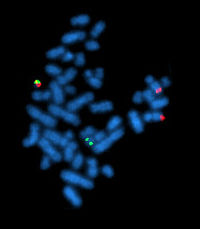
Photo from wikipedia
Introduction: Relapse of acute lymphoblastic leukemia (ALL) after allogeneic hematopoietic cell transplantation (HCT) is a therapeutic challenge. We present the case of a 20-year-old patient with a relapse of Philadelphia… Click to show full abstract
Introduction: Relapse of acute lymphoblastic leukemia (ALL) after allogeneic hematopoietic cell transplantation (HCT) is a therapeutic challenge. We present the case of a 20-year-old patient with a relapse of Philadelphia chromosome-negative ALL B-common over 2 years after HCT with no response to salvage chemotherapy or blinatumomab, who finally responded to a molecularly tailored therapy adjusted to the BCR-ABL1-like phenotype. Methods: The BCR-ABL1-like phenotype was diagnosed on the basis of an increased expression of ABL1 and CRLF2 genes. Results: We combined a nilotinib-based therapy targeting the overexpressed ABL1 gene with a proteasome inhibitor and Peg-asparaginase, achieving a spectacular response: the percentage of lymphoblasts in the bone marrow was reduced from 70% to 5%, which enabled a second HCT to be performed. Moreover, the relatively low toxicity of the treatment led to a good quality of life and no need for prolonged hospitalization. Conclusion: To our knowledge, this is the first successful use of nilotinib in BCR-ABL1-like phenotype ALL. This case should encourage routine clinical use of molecular data to individualize therapies targeting the overexpressed pathways responsible for leukemic cell proliferation, as a means to overcome chemoresistance.
Journal Title: Oncology Research and Treatment
Year Published: 2018
Link to full text (if available)
Share on Social Media: Sign Up to like & get
recommendations!